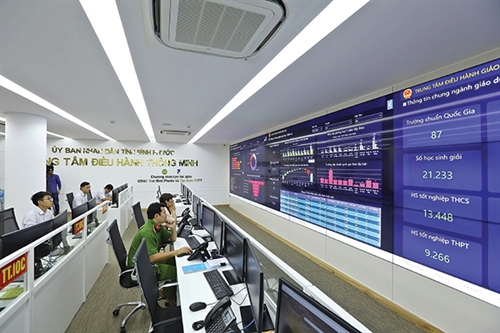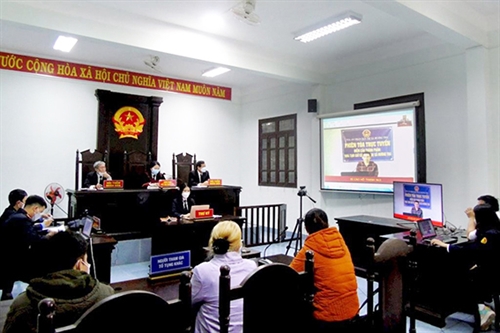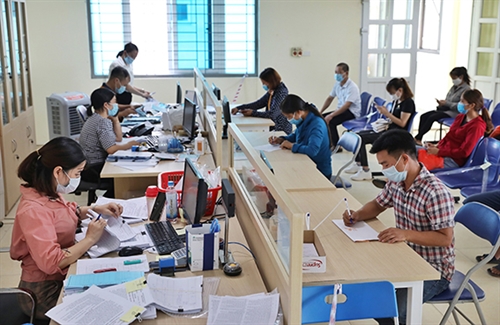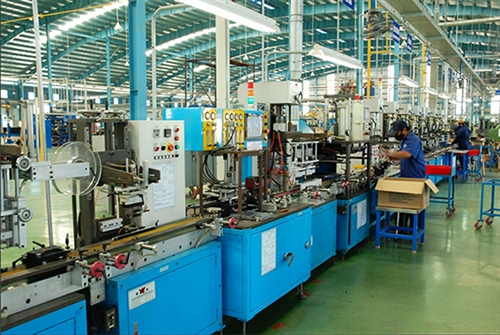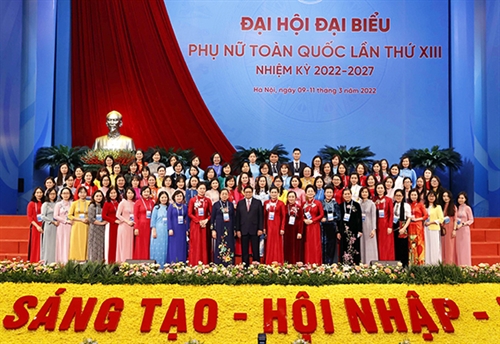>>Latest study sheds light on COVID-19 impacts on quality of governance and public services
Center for Research and Training, and United Nations Development Program
Introduction
This article is the second excerpt from the 2021 Vietnam Provincial Governance and Public Administration Performance Index (PAPI) Report[1], after the national overview published on the Vietnam Law and Legal Forum magazine in May 2022.[2] It presents key findings from the 2021 PAPI citizen surveys on how local governments performed in delivering on their mandates and public services across the eight PAPI dimensions (Participation at Local Levels, Transparency in Local Decision-making, Vertical Accountability, Control of Corruption in the Public Sector, Public Administrative Procedures, Public Service Delivery, Environmental Governance, and E-government).
This article also reveals aggregate PAPI scores by provinces as well as suggests ways forward for provincial governments to seek context-based solutions to address their shortcomings so as to satisfy citizens’ expectations and demand in the years to come. It, however, should be noted that, results from select indicators[3] - the most fine-grained elements that comprise dimensions - are of great importance, since they help provinces and interested readers learn more about local governments’ performances. The 2021 PAPI findings provided the baselines for the current 2021-26 government term. Thus, much greater attention should be paid to indicator-level findings than aggregate numbers at sub-dimensional and dimensional levels.
Participation at Local Levels
Participation in political, social and economic life is the constitutional right of all Vietnamese citizens from the age of 18. Such participation is key for citizens to exercise their democratic rights and do their part to help improve local governance. The 2021 PAPI survey findings show that, all provinces scored below 6 points on the 1-10 point scale in this dimension. As with previous years, provinces in the north tended to perform better in this dimension than those in the south. Some provinces in the Central Highlands and South Central Coast regions emerged into the top quartile.
When compared with the 2020’s findings, 14 provinces made positive and significant changes in 2021 (with the percentage change larger than 5 percent), while two-thirds saw scores decline significantly. As Figure 1 shows, Binh Duong, Bac Lieu, Lang Son, Thanh Hoa and Thua Thien-Hue were the provinces that made the most impressive year-on-year progress, while Ben Tre, Tien Giang, Dong Thap, Can Tho and Thai Nguyen saw the most significant declines.
The findings also indicated that all provinces performed poorly in citizen participation in elections, local-decision making and local infrastructure projects. Bringing electoral participation into focus, it seems proxy voting remained popular across all provinces during the 2021 elections for people’s representatives in the National Assembly and People’s Councils at provincial, district and commune levels. In more than two-thirds of all provinces, fewer than half of respondents said there was more than one candidate to select as village heads in these elections.
Moreover, local infrastructure projects commonly failed to benefit from citizens’ oversight, as the percentage of respondents noting that local Community Investment Supervision Boards were in place to monitor projects was below 50 percent in most provinces. The results were also notable for a continued decline in the sub-dimension on Voluntary Contribution to Local Projects. In 2015, more than half of respondents reported contributing to a local project, in contrast to around 38 percent in 2021. This indicates a decrease in willingness to contribute or local governments’ inability to mobilize contributions.
Transparency in Local Decision-making
This dimension sees PAPI measures how local governments facilitate access to government information and respond to civic rights in the four sub-dimensional areas of Access to Information, Transparency in Poverty Lists, Transparency in Commune Budget and Expenditure, and Transparency in Local Land Use Planning and Pricing.
Results from the 2021 PAPI survey show that all provinces scored between 4.2 to 6.25 points on the 1-10 point scale. Similar to previous years’ findings, northern provinces tended to perform more robustly, while peers in the South Central and Central Highlands regions trended in the opposite direction. Only 13 provinces made improvements in 2021 compared to the 2020 dimensional scores, while 23 other provinces saw year-on-year declines.
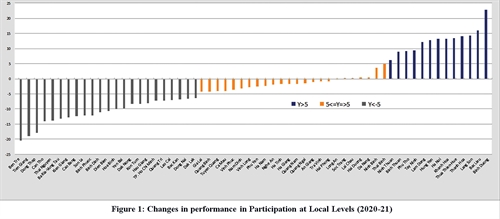 |
Regarding access to information, none of the provinces demonstrated sufficient dissemination and enforcement of the 2016 Law on Access to Information, making the sub-dimension on Access to Information the weakest. With respect to implementation of the law, only one-fifth of respondents from almost every province said they received information about state policies and legislation they requested.
Citizen access to information about local land plans in 2021 was limited nationwide, with just 5-30 percent of respondents accessing such information in almost every province (Figure 2). In addition, only 23-67 percent of respondents in all provinces knew where to become informed about local land pricing frameworks, which must be disclosed by provincial authorities on an annual basis. The COVID-19 pandemic was likely behind sharp recent changes in the transparency in land use plans indicator, with numbers in 2020 and 2021 falling to their lowest levels. Encouragingly, just 1.5 percent of respondents reporting land seized in 2021, while 3.7 percent reported farm land seized in 2021 compared to 5.1 percent in 2020.
 |
An important policy that local governments have to implement is disclosing communes’ budgets and expenditures on an annual basis for citizens to be informed, consulted and inputted. As the 2021 PAPI survey results showed, in two-thirds of all provinces, fewer than 50 percent of respondents said that communal budget and expenditure information was publicized. This contrasts with the requirement that such information is posted quarterly and biannually for public viewing for at least 30 days.
Vertical Accountability
This dimension in PAPI highlights how local governments respond to citizen requests, proposals, denunciations, complaints and/or petitions as well as citizen access to justice services. It consists of three sub-dimensions: Interactions with Local Authorities, Government Responsiveness to Citizen Appeals, and Access to Justice Services. The 2021 PAPI reveals that provincial performance in ensuring vertical accountability toward citizens remains a dimension that requires local governments to better comply with.
All provinces scored below 5 points on the 1-10 point scale. Also, none of the provinces made significant progress in 2021 compared to 2020. Ben Tre, Cao Bang, Quang Tri and Quang Binh saw declines of more than 20 percent points over the two years. The poorest-performing aspect for all provinces was handling citizens’ petitions and proposals, where below 40 percent of respondents sent petitions, complaints or proposals to local governments. Moreover, not all were responded to satisfactorily (Figure 3).
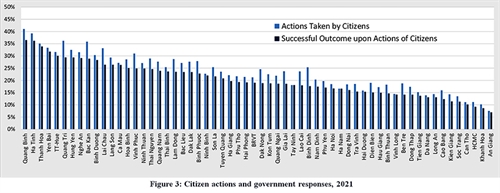 |
When encountering a problem, such as a civil dispute or disagreement with a local public official, citizens tend to approach commune People’s Committee officials more often than their elected representatives at commune People’s Councils to report and request assistance. This trend is evidenced across all provinces although the percentage of citizens counting on the People’s Committees when having such a problem remains very low, ranging from 7 percent to 35 percent across the country.
Moreover, non-court civil dispute mechanisms are not trusted by the majority of citizens in all provinces. Instead, respondents reported a preference for local courts rather than local mediation groups when engaged in a civil dispute.
Control of Corruption in the Public Sector
This dimension measures the performance of public institutions and local governments in controlling corruption in the public sector and reflects citizens’ tolerance of corrupt practices. It consists of sub-dimensions: Limits on Corruption in Local Governments, Limits on Corruption in Public Service Delivery, Equity in State Employment, and Willingness to Fight Corruption.
Unlike in the past 10 years when more southern provinces excelled, there was a more even regional distribution of the four tiers of performers across the country. Provincial scores in this dimension range widely from 5.42 points to 8.15 points on the 1-10 point scale. Twenty provinces made significant progress in 2021 compared to their performances in 2020. However, Binh Duong, Hai Phong, Lang Son and Lam Dong saw an increase by more than 15 percent points over the two years.
Equity in State Employment remains the weakest sub-dimension of all, with the highest provincial score at 1.69 points on the 0.25-2.5 point scale. Also, bribes for employment in the public sector cut across poor and wealthy provinces. Personal relationships remain important and very important for five commune-level public offices surveyed, even among top performers like Binh Duong and Thanh Hoa provinces. As with 2020, Dien Bien and Son La are still among provinces where personal relationships to have state employment are most profound.
Moreover, the proportions of applicants for land use rights certificates (LURCs) that paid a bribe ranged from 40 percent to 90 percent in more than two-thirds of all provinces. As shown in Figure 4, Bac Lieu, Quang Ngai, Tra Vinh, Yen Bai and Da Nang are the five provinces with the least number of respondents having had to pay bribes for LURCs. Surprisingly, the problem was more serious in poorer provinces like Cao Bang, Dak Lak and Soc Trang.
 |
Meanwhile, at district public hospitals, the proportions of healthcare service users that had to pay a bribe ranged from 40 percent to 80 percent in more than two-thirds of all provinces. The percentages were surprisingly higher than in previous years. The percentage of public district hospital users having to pay bribes in Nghe An, Son La, Thai Binh, Bac Kan and Lang Son was the highest of all (Figure 5). The COVID-19 pandemic might have made it harder for users to access the services due to travel and admission restrictions and, as a result, those who had to visit public district hospitals may have had to give bribes to be accepted.
 |
Public Administrative Procedures
This dimension reflects the quality of three public administrative services: certification services by local governments, construction permit application procedures handled at the district level, and LURC and personal paper application procedures handled by commune governments.
The year 2021 featured a more even distribution of good performers across all provinces, however, those in the Central Highlands and South Central Coast regions again lagged behind, as was the case in 2020. Procedures and administrative services for LURCs remain more problematic than those for local government certification and personal papers.
As for the quality of public administrative services for LURCs, applicants in most provinces reported similar experiences, except those in Son La where LURC applicants gave lower scores for district one-stop shop services. Missed deadline to issue LURCs seems a common problem in many provinces. Similarly, applicants in most provinces experienced a similar quality of public administrative services for personal papers, except those in Bac Kan, Dien Bien, Tra Vinh and Quang Tri, where users gave lower scores for commune one-stop shop services.
Concerning citizen experience with one-stop shops for LURCs and personal papers in 2021, applicants for LURCs were commonly required to engage with more officials during processing of their paperwork than applicants for personal papers (like birth, death and marriage certificates) in most provinces. Figure 6 shows that users of the two services in Ca Mau, Da Nang, Lam Dong, Long An and Tuyen Quang tended to have good experiences at both district (for LURCs) and commune (for personal papers) one-stop shops. The largest variations in terms of users’ experiences for both services are Quang Nam and Tien Giang.
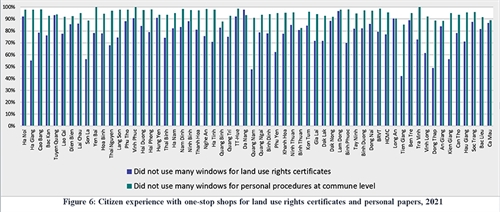 |
Public Service Delivery
This dimension examines four public services: healthcare, primary education, basic infrastructure, and law and order. To explore this dimension, citizens are asked about their experience of the accessibility, quality and availability of these services. As the 2021 PAPI results show, Dien Bien is the only province that scored below 7 points while other provinces scored from 7.14 points to 8.46 points on the 1-10 point scale.
The vast majority of provinces, as many as 50, received higher scores in 2021 than in 2020. Dien Bien, in seeing a large decline, was the exception, as shown in Figure 7. Public district hospitals in all provinces have room to improve, especially Ba Ria-Vung Tau, Binh Phuoc, Cao Bang, Dong Nai, Khanh Hoa, Lam Dong and Soc Trang. Users of hospitals in top performers, like Phu Yen and Thanh Hoa, still complained about bed-sharing, unclean restrooms and waiting times.
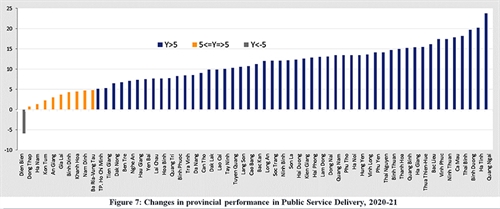 |
All provinces have scope to enhance the quality of public primary schools. During the second year of the pandemic, more than 60 percent of respondents in all provinces said their children’s schools were equipped with information and communication technology to facilitate online learning. Lower percentages, however, were found in mountainous or poorer provinces.
Although law and order improved in most provinces - potentially as a result of the pandemic and controls on movements of people - more victims of break-ins, robbery, thefts or physical violence were found in poorer provinces. Among 16 provinces where more than 10 percent of respondents were victims, only Ba Ria-Vung Tau, Dong Nai and Khanh Hoa are economically better off.
Environmental Governance
Citizens’ assessment of air and water quality as well as the integrity of local governments and businesses in protecting the environment are brought into sharp focus by this dimension. It sets some baselines to assist local governments in understanding environmental concerns over time.
The 2021 PAPI results exposed a clear divide among seven economic regions across Vietnam: provinces in the South Central, Central Highlands, Southeastern and Northeastern regions scored lower than those in the Northwestern, North Central and Mekong River Delta regions. Hubs of environmental concern remain the Red River Delta and Southeast regions where more industrial provinces are located, apart from the Central Highlands.
The perceived lack of local government commitment to enforce environmental protection remains evident. While less than 75 percent of respondents in all provinces agreeing that firms in their localities did not give bribes to local governments to bypass environmental regulations, the view of the remaining quarter underlines the work required by local authorities to gain the full trust of citizens in their ability to protect the environment. More respondents in Binh Duong, Ha Giang, Ha Tinh and Thua Thien-Hue provinces said they reported local environmental problems to local authorities and most received responses immediately (Figure 8).
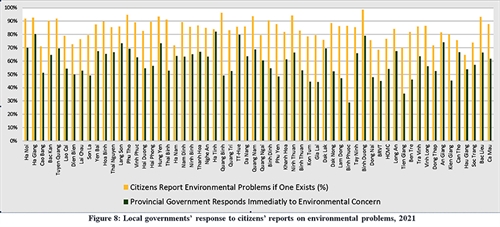 |
E-government
This dimension provides information about the availability of local government portals, access to e-government services and whether citizens have internet access - the enabling environment for citizens to participate in e-government.
The 2021 PAPI survey results show that, all provinces scored below 4 points on the 1-10 point scale, similar to the 2020 findings. The poorest-performing provinces were found in the northwest, northeast, Central Highlands and Mekong River delta regions. As Figure 9 shows, about half of all provinces made some year-on-year improvements compared to 2020. Lam Dong significantly stepped up its performance in 2021, while Cao Bang and Hoa Binh saw sharp declines from 2020. Among localities in the top quartile, three were centrally governed municipalities: Da Nang, Hanoi and Ho Chi Minh City.
 |
At the provincial level, there remains a large divide between access to internet and access to e-government portals for e-services from citizens’ experiences. Localities like Binh Duong, Binh Phuoc, Hanoi, Hung Yen, Lam Dong, Thua Thien-Hue and Vinh Phuc made some progress in provision of e-services for their citizens in 2021. In contrast, Cao Bang, Hoa Binh, Quang Ngai and Vinh Long regressed compared to 2020.
| Figure 10: Provincial performance in Governance and Public Administration by quartiles, 2021 |
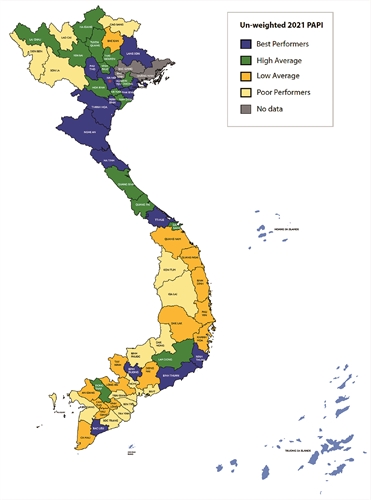 |
Aggregate 2021 PAPI scores
The 2021 PAPI Report also provides an overview of aggregate performance across provinces, calculated by adding up each province’s scores in the eight PAPI dimensions. This allows provinces to assess how they perform relative to other provinces with similar socio-economic and geographic endowments. Deeper dives into sub-dimension and indicator-level findings are key for those provinces that wish to effectively respond to their citizens’ expectations. This need is especially critical to understand the impacts of the COVID-19 pandemic on governance and to help provinces prepare for future economic and health crises.
The analysis of the 2021’s data shows that more better-performing provinces are found in the northern region, as shown in Figure 10, in contrast to the Central Highlands, South Central Coast and Mekong River Delta provinces that appear to have fallen behind. Among the five centrally run municipalities, Ho Chi Minh City is in the lowest-performing quartile, may be a result of long-term lockdowns during the COVID-19 outbreak that impeded citizens’ access to local government and public services. Compared to the 2020’s findings, 30 provinces made improvements in performance in Public Service Delivery, Environmental Governance and E-government. However, 30 others saw declines in dimensional scores of Participation at Local Levels, Transparency in Local Decision-making, Vertical Accountability, and Control of Corruption in the Public Sector.
Overall, there was a wider difference in provincial performance in Public Service Delivery in 2021. However, declines in highest and lowest 2021 provincial scores were evident in Participation at Local Levels, Transparency in Local Decision-making, Vertical Accountability, and Control of Corruption in the Public Sector.
Key takeaways
The 2021 PAPI survey findings from this article carry with them the following two key takeaways, apart from those implied in each indicator:
- PAPI is an annual assessment of not only local governments’ performances in governance and public administration, but also citizens’ preferences and concerns especially during the second year of the COVID-19 pandemic. PAPI consists of data points that should be explored by provincial authorities to understand their citizens’ feedback and expectations. As an aggregate index, PAPI serves as a dashboard that shows a province’s performance in a certain year in a holistic manner.
- 2021 is the first year of the 2021-26 government tenure. The 2021 PAPI findings provide baselines for provincial governments to review their performance overtime toward 2026. The level of detail presented through 120 indicators will help provinces prioritize their areas of focus and assign tasks and mandates to relevant local government agencies in order to increase citizen satisfaction with their performance. The devil is in the details.-


